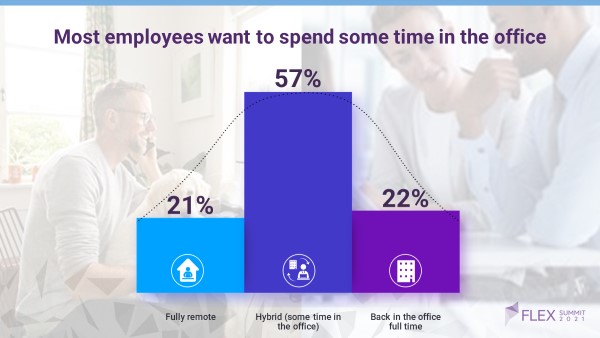The term hybrid work is already sounding a bit overworked, but enterprises still have a way to go to figure things out. Technology is the least of their problems; it’s fair to say that during the pandemic UCaaS vendors, in particular, have done a great job of adapting and enhancing their offerings for what’s becoming the new normal.
During its recent analyst event, one of those UCaaS providers, Fuze, shared some highlights from its “
Flex Study 2021,” a global research initiative covering the U.S., Australia, U.K., and France. With a response base of 8,811, the data set was substantive. Here I address some highlights that will give IT decision-makers a more holistic perspective on the value of collaboration technologies for hybrid work.
Having a flexible workforce, driven by culture and values, is a central concept of Fuze’s research. Given how fluid everything has become during the pandemic, it’s not surprising that flexibility has become so important — not just for how work gets done, but where, when, and by whom.
Today’s technology makes much of this possible, and management has little choice but to be flexible. The command-and-control model, which has served IT so well for so long, has little place in a world where cloud-based applications are very user-centric, and shadow IT is the natural response when IT is unwilling or unable to keep up with workers’ changing needs.
When workplace conditions are flexible, today’s UCaaS offerings can drive significant gains in productivity, but it’s not just due to the technology we spend so much time focusing on. Managers must trust that workers will be more engaged, more creative, more committed, etc., with a flexible workplace, and workers will likewise have to trust their managers.
On paper, this means more flexible policies that allow employees to work in the ways that best suits them. But it also reflects a more open-ended mindset that doesn’t tether to the legacy notion that work could only get done in the physical spaces housing all the requisite equipment. With that in mind, three inter-related themes emerged from the research (see image below):
Trust Holds the Key to Productivity
Instinctively, we know how important trust is for any form of human interaction, and it’s long been a setback for remote work. Once beyond the purview of managers, supervisors, and IT — workers could easily be distracted — and it was difficult to gauge how hard people were working. If managers and supervisors can’t trust employees to work effectively in this way, then it’s easy to see why IT has resisted technologies that support remote work. While that may be a good strategy for IT to maintain control over workers, those same technologies can help the business reduce costs, enhance automation, and drive innovation.
The good news is that work from home was forced on most businesses, so IT had little choice in the matter. These new work styles have become normalized over the last year and a half, and to the surprise of many, remote work has proven to be quite effective. Aside from yielding better productivity results, remote work has served to build trust with management, and that’s key for maintaining a flexible workplace that welcomes the next wave of technology innovation.
The data points in the graphic below reflect the perception of most workers who believe management has become more trusting of remote work since the pandemic started. In terms of takeaways for readers, managers and supervisors must view trust as a foundation for success with hybrid work. When workers feel properly supported working from home, they’ll find it easier to balance things out when working at other times in the office. Both are necessary for hybrid work.
Flexibility: Where People Work
Another recurring theme about hybrid work has been the need to support both ends of the spectrum — working from home and in the office. Fuze’s research validated the
Bell curve effect that companies often tout for hybrid work — namely, how the majority desires a mix, and only a minority wants to go all-in for either home-based or office-based work.
The data distribution in the graphic below speaks for itself but also underscores the importance of flexibility as outlined above. Companies will need to support both models, and the productive enterprise is the one that enables workers to be equally effective in both settings. Not only does this require inherent flexibility, but it also requires a high degree of trust that workers will be more productive when giving them more agency about their working conditions.
It’s worth noting that none of these distinctions matter to the UCaaS vendors as they build out their offerings. Their solutions work equally well in both settings, so success with hybrid work isn’t a technology problem. This reality could be a convenient holdback for enterprises reluctant to keep supporting work from home as the pandemic fades. But the reality is that the other factors addressed here play a bigger role.
Have We Overestimated the Pandemic?
For businesses that have embraced hybrid work and deployed UCaaS around supporting that model, the results seem to be pretty good. Technology alone doesn’t guarantee any improvement. However, when supported by the right conditions, the hoped-for productivity gains are very likely to materialize. To be fair, productivity isn’t easily measured, and it has long been a weak spot in the marketing toolkit for UCaaS vendors.
In the absence of solid metrics for productivity, the next best thing would be worker sentiment, and the data set above illustrates this well. Many workers and senior leadership feel they’ve been more productive than before the pandemic. Meanwhile, a near-unanimous 86% feel they are either more productive or as productive. There may be a fair bit of subjectivity here since “more” isn’t measured, and we don’t know what “feel” truly means. However, the sentiment is clear, and it’s a strong indicator that when all the factors addressed in this post are aligned, better outcomes should follow.
To learn more about UCaaS and workplace strategies, attend Enterprise Connect this September 27-29 in Orlando, Fla.
Register now with promo code
NJAL200 and receive $200 off your registration.
This post is written on behalf of BCStrategies, an industry resource for enterprises, vendors, system integrators, and anyone interested in the growing business communications arena. A supplier of objective information on business communications, BCStrategies is supported by an alliance of leading communication industry advisors, analysts, and consultants who have worked in the various segments of the dynamic business communications market.













